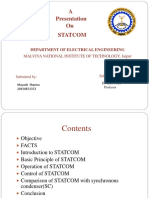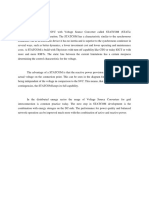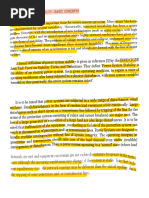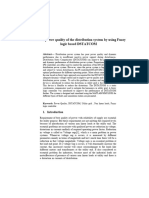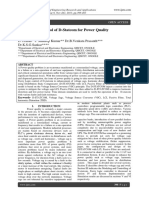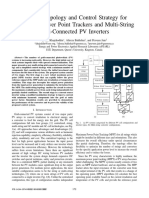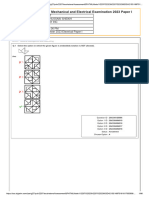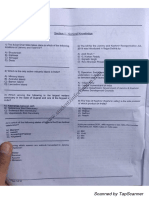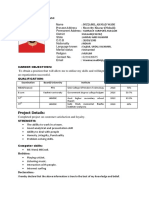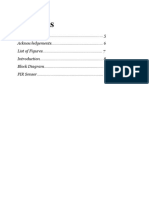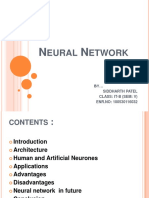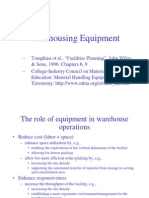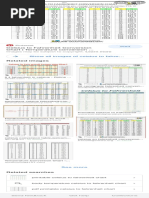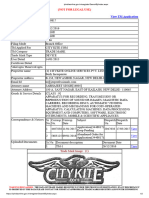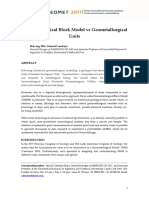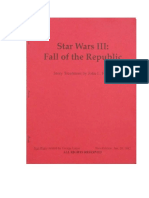Power Quality Improvement by Using Modular Multilevel Cascade Converter Based Statcom
Power Quality Improvement by Using Modular Multilevel Cascade Converter Based Statcom
Uploaded by
Mudasir GureziCopyright:
Available Formats
Power Quality Improvement by Using Modular Multilevel Cascade Converter Based Statcom
Power Quality Improvement by Using Modular Multilevel Cascade Converter Based Statcom
Uploaded by
Mudasir GureziOriginal Title
Copyright
Available Formats
Share this document
Did you find this document useful?
Is this content inappropriate?
Copyright:
Available Formats
Power Quality Improvement by Using Modular Multilevel Cascade Converter Based Statcom
Power Quality Improvement by Using Modular Multilevel Cascade Converter Based Statcom
Uploaded by
Mudasir GureziCopyright:
Available Formats
Proceedings of the Second International Conference on Inventive Systems and Control (ICISC 2018)
IEEE Xplore Compliant - Part Number:CFP18J06-ART, ISBN:978-1-5386-0807-4; DVD Part Number:CFP18J06DVD, ISBN:978-1-5386-0806-7
Power Quality Improvement by Using
Modular Multilevel Cascade Converter based
STATCOM
Yogita R. Ashtekar
Assistant professor, Anuja A. Mude Sneha A. Khubalkar
Department of Electrical Assistant professor, Assistant professor,
Engineering, DMIETR, Sawangi, Department of Electrical Department of Electrical
Wardha, India Engineering, DMIETR, Sawangi, Engineering, DMIETR, Sawangi,
E-mail: Wardha, India Wardha, India
snehalashtekar87@gmail.com E-mail: anujamude@gmail.com E-mail: akhsneha@gmail.com
Abstract— Quantity of the output power delivered from the Series Compensator- SSSC and Unified Power Flow
utilities has become major concern of the modern industries for Controller (UPFC). STATCOM is a popular FACTS
the last decade. The power quality associated problems are
voltage sag, flicker , voltage imbalance, interruption and controller to support the voltage, improve the transmission
harmonics problems which results in the malfunctutioning of capability, enhance the voltage stability and increase the
equipment’s in the industries by affecting the microprocessor transient stability by injecting/absorbing the reactive power
based loads, sensitive electric components which are highly
to/from the power system at the point of common coupling.
sensitive to voltage level fluctuation. The power consumed by the
heavy load creates unsymmetrical currents which results in Modular Multilevel converter (MMC) based STATCOM is an
reduced power quality in the electrical grid. The stimulating extended topology of STATCOM with enhanced power
functions of Flexible AC Transmission system (FACTS) estimate quality as it reduces the harmonic contamination injected by
the critical clearing time, voltage regulation, steady state power
flow and oscillation damping control. The main objective of this
the STATCOM into the power system.
paper is the application of modular multilevel cascade (MMC)
converter based Static synchronous Compensator (STATCOM) The complete simulation of the Modular Multilevel Converter
for reactive-power control and improved power quality. The based STATCOM within a power system is performed in the
complete simulation of this system is performed in the MATLAB MATLAB software and the PI control is used for the
software and the PI control is used for the controlling. controlling. The control circuit uses PWM technique for
controlling action. The MMCCs will be classified into four
Keywords— Flexible AC Transmission system (FACTS), Static types such as single-star bridge cells (SSBCs), single-delta
synchronous Compensator (STATCOM), modular multilevel
bridge cells (SDBCs),double-star chopper cells (DSCCs) and
cascade (MMC), insulated-gate bipolar transistors (IGBT)
double-star bridge cells (DSBCs).
I. INTRODUCTION
The term bridge cell is a single-phase full bridge converter, and
The power quality problems in power system happens in
chopper cell consisting of a dc capacitor and two IGBT. The
millisecond and because of time limitation it requires fast
Double - star bridge cells (DSBCs)are suitable for a Static
operating custom devices. FACTS technology is the
synchronous Compensator (STATCOM) for voltage regulation
application of a variety of new power electronic controllers for
problem of eliminating harmonics. The output waveform of
both active and reactive power compensation. The stimulating
multilevel converter is in a stepped wave form resulting in
functions of FACTS estimate the critical clearing time, voltage
reduced harmonics compared to square wave converter [12].
regulation, steady state power flow and oscillation damping
control. The insertion of such controllers in power system
enables an approach to plan a better reactive power II. POWER QUALITY ISSUES / PROBLEMS
management scheme which improves voltage profile, utilizes The gradual change in power system leads to shortage of
the existing transmission system assets, increases transmission reactive power leading to power instability. With increased
system reliability, amplifies transient grid stability and reduces power flow, there is corresponding decrease in voltage at the
loop flow. Highly adaptable, efficient FACTS controllers exist bus which results in shortage of reactive power. Power Quality
that are rapidly emerging in power systems and includes Static issues are mainly Voltage sag, Voltage swell, Micro
Synchronous Compensator - STATCOM, Static Synchronous interruptions, Transients and Harmonics. The consequences of
978-1-5386-0807-4/18/$31.00 ©2018 IEEE 169
Proceedings of the Second International Conference on Inventive Systems and Control (ICISC 2018)
IEEE Xplore Compliant - Part Number:CFP18J06-ART, ISBN:978-1-5386-0807-4; DVD Part Number:CFP18J06DVD, ISBN:978-1-5386-0806-7
these issues are flickering lights, equipment shutoff, loss of A. Capacitor Voltage Balancing
data and damaged to equipments.So in this paper MMC In the MMC, modules are constantly inserted into and
Converter based STATCOM is tested for these issues to bypassed out of the system. In order to keep the capacitor
prevent the system, reaching this state is to augment reactive voltages as evenly distributed as possible, not any module
power support. should be operated at any given time. The modules inserted or
bypassed have to be selected. Any failure to the module
III. STATIC SYNCHRONOUS COMPENSATOR (STATCOM) insertion results in the distortion of the output voltage which
STATCOM is made up of a coupling transformer, a VSC and may cause equipment damage. This selection is based on the
a dc energy storage device. STATCOM is capable of direction of the current in the arm.
exchanging reactive power with the transmission line because
of its small energy storage device i.e. small dc capacitor, if B. Phase-Shifted Sinusoidal Pulse-Width Modulation (PS-
this dc capacitor is replaced with dc storage battery or other dc SPWM)
voltage source, the controller can exchange real and reactive As in regular SPWM, the signal to be modulated is compared
power with the transmission system, extending its region of to a high frequency triangular waveform. To take advantage of
operation from two to four quadrants. A functional model of a the higher number of levels, PS-SPWM uses as many different
STATCOM is shown in Fig.1. phase-shifted triangular waveforms as there are converter
levels. The waveforms are phase-shifted so that the switching
instants of the different modules are offset in time, thus
reducing the harmonics in the output signal, In the example,
the frequency of the triangular waveform is 360Hz, only 6
times that of the modulating signal. It can be seen in the graph
showing the harmonic contents of the modulating signal
however, that the apparent switching frequency is much
higher, in this case, the lower harmonics are centered around
1800Hz, 5 times higher than the individual modules switching
frequency as there are 5 modules per arm. This illustrates a
Fig.1 Basic Operation of STATCOM
major advantage of the MMC, which is a substantial reduction
If the amplitudes of the ac system and converter output in losses as each module switches at only a fraction of the
voltages are equal, there will be no ac current flow in/out of overall equivalent switching frequency. This advantage
the converter and hence there will be no reactive power becomes more attractive as the number of modules increases,
generation/absorption the ac current magnitude can be either producing a higher apparent output frequency, or
calculated using the following equation[13]. lowering the switching frequency of individual modules. From
the figure, the underlying sinusoidal waveform can easily be
−V noticed. Compared to the SPWM technique it is clear that this
=
signal contains much smaller harmonics, as confirmed by the
harmonic content. The difference can be clearly seen with
Assuming that the ac current flows from the converter to the
only 5 levels. This becomes more visible as the number of
ac system. The corresponding reactive power exchanged can
modules increases, reducing, and potentially removing
be expressed as follows.
altogether, the requirements for filters.
−V
= C. Principle Of Operation Of MMC
Fig.2 and 3 shows the typical structure of a MMC and the
The real power exchange between the voltage-sourced configuration of a Sub-Module (SM) respectively.
converter and the ac system can be calculated as follows.
IV. MODULAR MULTILEVEL CONVERTER (MMC)
Load is connected to PCC. STATCOM can be connected
on either side i.e. towards load side or Source side. The MMC
STATCOM topology consists of different blocks.
Fig:-2 Three-phase Modular Multi-level Converter
978-1-5386-0807-4/18/$31.00 ©2018 IEEE 170
Proceedings of the Second International Conference on Inventive Systems and Control (ICISC 2018)
IEEE Xplore Compliant - Part Number:CFP18J06-ART, ISBN:978-1-5386-0807-4; DVD Part Number:CFP18J06DVD, ISBN:978-1-5386-0806-7
In MMC the switching sequence is controlled so that at each
From the above Fig.2 the output voltage UO is given by, instant only N SMs are in the on-state. Selection algorithm of
inserted or bypassed SMs during each sampling period of the
UO = UC if T1 is ON and T2 is OFF
control system results in equal voltage sharing among the
UO = 0 if T1 is OFF and T2 is ON capacitor of each arm can be achieved by a typical voltage
Where UC is the instantaneous capacitor voltage. waveform of a multi-level converter is shown in Fig.6.
Fig.3 shows If T1 and T2 both are ON or OFF at the same
instant that configuration should not be considered because it
determines a short circuit across the capacitor and produces
different output voltages depending on the current direction
respectively. The current flows in both useful states. The
number of steps of the output voltage in MMC is related to
the number of series connected SMs.
Fig:-6 Voltage waveform of a Multi-Level Converter
V. SIMULATION OF MODULAR MULTILEVEL CASCADE
CONVERTER BASED STATCOM
The system is connected with 66 kV Source voltage, the
ratings of STATCOM is mentioned in Table -I of parameters.
We used Modular multilevel converter to the STATCOM
which is connected parallel to the transmission line. MMC
Fig:-3 Schematic of one phase of Three-Level Converter STATCOM supplies reactive power to transmission line.
Reactive power is supplied with the help of VSC which is
The zero state can be obtained through two possible switch consists of Modular Multilevel Converter circuit with
configurations. Two SMs in the middle of a leg 2 and 3 are IGBT’s. System is studied under three different conditions.
bypassed in first one and in second one is the end SMs of a leg 1) System under Steady state
1 and 4 are bypassed. In order to get the positive output, 2) System Under Sag condition
+UD/2, the two upper SMs 1 and 2 are bypassed. Similarly, 3) System Under Fault condition
for - UD/2, the two lower SMs 3 and 4 are bypassed. Both the
zero states must be used alternatively in order to keep the
capacitor voltages balanced. Fig.4 shows the voltage
waveform generated by the three level converters.
Fig.4 Voltage waveform of a Three-Level Converter
The principle of operation can be extended to any multi-level
configuration as the one represented in Fig.5
Fig.7 Simulation of Modular Multilevel Cascade converter Based STATCOM
Fig.5 Schematic of one phase of Multi-Level Converter
978-1-5386-0807-4/18/$31.00 ©2018 IEEE 171
Proceedings of the Second International Conference on Inventive Systems and Control (ICISC 2018)
IEEE Xplore Compliant - Part Number:CFP18J06-ART, ISBN:978-1-5386-0807-4; DVD Part Number:CFP18J06DVD, ISBN:978-1-5386-0806-7
In steady state, the STATCOM performance is studied. All the case bus voltage and 1 pu, more is the source voltage
voltages are well balanced and regulated. The good magnitude and of STATCOM and vice- versa.
waveforms of voltage and STATCOM current at the PCC bus
show that passive filter becomes unnecessary.
Table – I
Sr. System System Specifiaction
No. Parameter
1 IGBT Internal resistance:-1e-3Ω
Snubber resistance -1e5Ω
Fig.10 Source Voltage in 3 Phase Fault condition with STATCOM
2 Line 15.9 mhenry
Inductance x 10
4
ISa
1
3 Line 0.5929 Ω
Resistance 0.5
4 Base Voltage 66 kV
Current (Amp)
5 For RL Load Active Power:- 47.5 MW 0
Inductive reactive power:- -0.5
0.15MW
6 For RL1 Load Active Power:- 47.5 MW -1
0 0.1 0.2 0.3 0.4 0.5 0.6 0.7
Inductive reactive power:- Time
Fig.11 Source Current in Fault condition with STATCOM
0.15MW
7 SM Capacitor 3 microfarad Fig.12 and 13 shows Source voltage for different types of
VI. RESULTS faults such as LL Faults, LLG faults has been analyze by
magnitude of voltage.
Fig.8 & 9 shows the magnitude of source voltage and current
without STATCOM under fault condition in which magnitude
of voltage is reduced from 63.27 kV to 31.63 kV for sag
condition from duration 0.2 sec and then decrease to 0 volt
for transient fault for (0.3-0.4) sec transition period & Current
magnitude rises from 510A to 5027A for transient fault for
(0.3-0.4) sec transition period respectively.
Fig.12 Source Voltage in LL Fault condition with STATCOM
Fig.8
Source Voltage in 3 Phase Fault condition without STATCOM Fig.13 Source Voltage in LLG Fault condition with STATCOM
STATCOM inject reactive power of 82 MVAR in system to Fig.14 and 15 shows voltage and current at PCC during fault
restore the voltage to normal condition. without and with STATCOM for different types of fault such
as three phase and LLG fault.
ISa
8000
6000
4
x 10 V_PCC
6
4000
4
Current(Amp)
2000
Voltage(Volt)
0 0
-2
-2000
-4
-4000
-6
0 0.1 0.2 0.3 0.4 0.5 0.6 0.7
-6000
0 0.05 0.1 0.15 0.2 0.25 0.3 0.35 0.4 0.45 0.5
Time
Fig.9 Source Current in Fault condition without STATCOM 0.5
Current (Amp)
Fig.10 and 11 shows the magnitude of source voltage and 0
current with STATCOM under fault condition. It is observed
-0.5
-1
that source voltage Magnitude of STATCOM is greater than
0 0.1 0.2 0.3 0.4 0.5 0.6 0.7
Time
unity for raising the bus voltage to 1 pu and less then unity for Fig.14 Voltage and Current at PCC during three phase Fault without
lowering it to 1 pu. Hence more the difference between base STATCOM
978-1-5386-0807-4/18/$31.00 ©2018 IEEE 172
Proceedings of the Second International Conference on Inventive Systems and Control (ICISC 2018)
IEEE Xplore Compliant - Part Number:CFP18J06-ART, ISBN:978-1-5386-0807-4; DVD Part Number:CFP18J06DVD, ISBN:978-1-5386-0806-7
REFERENCES
[1] H. Akagi, “Classification, terminology, and application of the modular
multilevel cascade converter (MMCC),” IEEE Trans. Power Electronics,
vol. 26, no. 11, pp. 3119–3130, Nov. 2011.
[2] J. S. Lai and F. Z. Peng , “Multilevel converters-A new breed of power
converters,” IEEE Trans. Ind. Appl., vol. 32, no. 3, pp. 509–517,
May/Jun. 1996.
[3] F. Z. Peng and J. S. Lai, “Dynamic performance and control of a static
var generator using multilevel inverters,” IEEE Trans. Ind. Appl., vol.
33, no. 3, pp. 748–755, May/Jun. 1998.
[4] Y. Liang and C. O. Nwankpa, “A new type of STATCOM based on
cascading voltage-source inverters with phase-shifted unipolar SPWM”,
IEEE Trans. Ind. Appl, vol. 35, no. 5, pp. 1118–1123, Sep./Oct. 1999.
Fig.15 Voltage and Current at PCC during 3phase Fault with STATCOM [5] S. Sirisukprasert, A.Q. Huang ,“Modeling analysis and control of
cascaded-multilevel converter-based STATCOM,” in Proc. Power Eng.
Soc. Gen. Meeting, 2003, pp. 13–17.
Fig.16 and 17 shows Load Active and Reactive power for [6] C.K. Lee, J. S. K. Leung, S. Y. R. Hui, and H. S. H. Chung, “Circuit-
three phase fault with and without STATCOM. Similarly level comparison of STATCOM technologies,” IEEE Trans. Power
Electron., vol. 18, no. 4, pp. 1084–1092, Jul. 2003.
Results obtained for LL fault with STATCOM. [7] F. Z. Peng and J. Wang, “A universal STATCOM with delta connected
Cascade multilevel inverter,” in Conf. Rec. IEEE PESC, 2004, pp.
12
x 10
7
P&Q load
3529–3533.
10
[8] H. Mohammadi Pirouzy and M. Tavakoli Bina “Modular Multilevel
Converter Based STATCOM Topology Suitable for Medium-Voltage
8
Unbalanced Systems”, Journal of Power Electronics, September
2010,Vol. 10, No. 5, pp. 1534 – 1545.
Power
[9] Wei Li, L.-A. and J. Bélanger, “Modeling and Control of a Full-Bridge
Modular Multilevel STATCOM”, Power and Energy Society General
4
2
Meeting, 2012 IEEE 22-26 July , 2012,pp.1 – 7.
0
[10] T. Yuvaraja, S.Mazumder, “Performance and Analysis of Modular
Multilevel Converter”; American Journal of Engineering Research
0 0.05 0.1 0.15 0.2 0.25 0.3 0.35 0.4 0.45 0.5
Time
Fig.16 Load Active Power & Reactive Power under Fault Condition without (AJER) 2014 e-ISSN : 2320-0847 p-ISSN : 2320-0936 Volume-03,
STATCOM Issue-01, pp. 01-08.
[11] R. Naderi, A. Rahmati “Phase-shifted carrier PWM technique for
general cascaded inverters”, IEEE Trans. Power Electron., vol. 23, no.
3,pp. 1257–1269, May 2008.
[12] S. Madichetty, A. Dasgupta, “Modular Multilevel Converters Part-I: A
Review on Topologies, Modulation, Modeling and Control Schemes”,
International Journal of Power Electronics and Drive System (IJPEDS)
Vol. 4, No. 1, March 2014 pp. 36-50.
[13] K. Atal, R. K. Sandhu, “An Implemented Approach of Fuzzy Logic
Based Controlled STATCOM”, International Journal of Advance
Engineering and Research Development, Volume 2, Issue 3,
March2015, PP.487-496.
Fig.17 Load Active Power & Reactive Power under Fault Condition with
STATCOM
VII. CONCLUSION
In this paper a full-bridge MMC converter based STATCOM
model is implemented and stimulated with PSPWM scheme.
In this system, the SM capacitor voltages are balanced by two
control loops, one equalizes the capacitor energy among three
phases, and the other balances the capacitor voltage within
each arm. This scheme has fast response and minimum impact
on the STATCOM voltage and current harmonics. The MMC
STATCOM and its controller are validated in a test system for
scenarios, i.e. the steady state, voltage sag, 3-phase-ground ac
fault and the obtained results shows the proposed control
scheme is effective and robust. The STATCOM has fast
response to voltage sag, and fast recovery after ac or dc faults,
even without protection circuits.
978-1-5386-0807-4/18/$31.00 ©2018 IEEE 173
You might also like
- Understanding The Yield Curve, Part 6 - A Framework For Analysing Yield CurveDocument28 pagesUnderstanding The Yield Curve, Part 6 - A Framework For Analysing Yield CurvephlymsNo ratings yet
- RFP Leadership Development ProgramDocument33 pagesRFP Leadership Development ProgramChristianNo ratings yet
- Dstatcom BessDocument7 pagesDstatcom BessSYAHRUN MUBAROKNo ratings yet
- 1 Power Quality Improvement by Using DSTDocument12 pages1 Power Quality Improvement by Using DSTseeratashraf5001No ratings yet
- Enhancement of Power Quality in Grid Connected Wind Energy System Using STATCOMDocument9 pagesEnhancement of Power Quality in Grid Connected Wind Energy System Using STATCOMShaik Muhammad ImranNo ratings yet
- VSC Based DSTATCOM & Pulse-Width Modulation For Power Quality ImprovementDocument4 pagesVSC Based DSTATCOM & Pulse-Width Modulation For Power Quality Improvementsurendiran123No ratings yet
- CHB Multilevel Inverter With Sliding Mode Controller For DSTATCOM ApplicationsDocument9 pagesCHB Multilevel Inverter With Sliding Mode Controller For DSTATCOM ApplicationsInternational Journal of Power Electronics and Drive SystemsNo ratings yet
- Research Article: Mitigation of Voltage Dip and Voltage Flickering by Multilevel D-STATCOMDocument11 pagesResearch Article: Mitigation of Voltage Dip and Voltage Flickering by Multilevel D-STATCOMAhmed Mohamed HassanNo ratings yet
- A New Control Scheme For Power Quality Improvement With StatcomDocument7 pagesA New Control Scheme For Power Quality Improvement With Statcomsaran killerNo ratings yet
- FACTS DevicesDocument19 pagesFACTS DevicesMAYANK SHARMANo ratings yet
- STATCOMDocument5 pagesSTATCOMVenkateshNo ratings yet
- Design of Multi-Level Inverter and Its Application As Statcom To Compensate Voltage Sags Due To FaultsDocument6 pagesDesign of Multi-Level Inverter and Its Application As Statcom To Compensate Voltage Sags Due To FaultsManpreet SinghNo ratings yet
- Static Synchronous Compensator STATCOM FDocument6 pagesStatic Synchronous Compensator STATCOM FchetanNo ratings yet
- 632154ijsetr12332 1456Document4 pages632154ijsetr12332 1456nadia alfituriNo ratings yet
- Enhancement of Power System Quality UsinDocument9 pagesEnhancement of Power System Quality UsinchetanNo ratings yet
- Power Quality ImprovementDocument4 pagesPower Quality ImprovementMogal RajeshNo ratings yet
- Transient Modelling of STATCOMDocument6 pagesTransient Modelling of STATCOMSwechhya kafleNo ratings yet
- Power Quality Improvement in Modified Solid State Transformer System Using StatcomDocument6 pagesPower Quality Improvement in Modified Solid State Transformer System Using StatcomdevchandarNo ratings yet
- Transient Stability of Power System by Static VAR Compensator (SVC) and Power System Stabilizers (PSS) Using Matlab/SimulinkDocument5 pagesTransient Stability of Power System by Static VAR Compensator (SVC) and Power System Stabilizers (PSS) Using Matlab/SimulinkArunima SahaNo ratings yet
- Sen 2017Document6 pagesSen 2017kaaisNo ratings yet
- Hvdc notesDocument29 pagesHvdc notesMANNAT RAINANo ratings yet
- Q StatcomDocument18 pagesQ StatcomHesham A. HazaymehNo ratings yet
- Operation of D Statcom in Voltage Control Mode IJERTV7IS090086Document8 pagesOperation of D Statcom in Voltage Control Mode IJERTV7IS090086harinijeyasri7No ratings yet
- Presentation About Statcom: Submitted By:-Md Nasim LE-21156Document8 pagesPresentation About Statcom: Submitted By:-Md Nasim LE-21156Tauqeer AhmadNo ratings yet
- A MMC Based Three-Phase Wind Energy Inverter (WEI) With Flexible AC Transmission SystemDocument6 pagesA MMC Based Three-Phase Wind Energy Inverter (WEI) With Flexible AC Transmission SystemInternational Journal of Engineering and TechniquesNo ratings yet
- Indirect Control Techniques For Cascaded Multilevel Inverter (CMLI) STATCOM:A ReviewDocument4 pagesIndirect Control Techniques For Cascaded Multilevel Inverter (CMLI) STATCOM:A ReviewRavinder RangaNo ratings yet
- 29-04-2021-1619695048-6-Ijeee-2. Ijeee - Power Quality Improvement Using Fuzzy Based StatcomDocument10 pages29-04-2021-1619695048-6-Ijeee-2. Ijeee - Power Quality Improvement Using Fuzzy Based Statcomiaset123No ratings yet
- Seminar ReportDocument18 pagesSeminar ReportLakshmi ZaharaNo ratings yet
- Flexible Ac Transmission ControllersDocument9 pagesFlexible Ac Transmission ControllersYekanth KolaNo ratings yet
- IOSR JournalsDocument6 pagesIOSR JournalsInternational Organization of Scientific Research (IOSR)No ratings yet
- 9 D-StatcomDocument50 pages9 D-StatcomSivakumar Kala100% (2)
- 1.1.3 Flexible AC Transmission System (FACTS)Document14 pages1.1.3 Flexible AC Transmission System (FACTS)Richardson PaduaNo ratings yet
- Design and Performance Evaluation of Subsynchronous Damping Controller With StatcomDocument9 pagesDesign and Performance Evaluation of Subsynchronous Damping Controller With StatcomThanh PhamNo ratings yet
- Performance Evaluation of D-Statcom For Voltage Fluctuations in Power Distribution SystemDocument4 pagesPerformance Evaluation of D-Statcom For Voltage Fluctuations in Power Distribution SystemNateNo ratings yet
- Paper - The Best of Both - FINALDocument5 pagesPaper - The Best of Both - FINALGabriela EftemieNo ratings yet
- 39 Submission 1Document14 pages39 Submission 1Thimothy BasavaNo ratings yet
- Simulations and Experimental Verification of An All-Active Hybrid Converter Arrangement For Filtering Power System Harmonics andDocument6 pagesSimulations and Experimental Verification of An All-Active Hybrid Converter Arrangement For Filtering Power System Harmonics andshiks16No ratings yet
- Power Quality Improvement For Non Linear Ffe96ec1Document6 pagesPower Quality Improvement For Non Linear Ffe96ec1Muhammad AzisNo ratings yet
- Enhancement of Power System Dynamics Using A Novel Series Compensation SchemeDocument7 pagesEnhancement of Power System Dynamics Using A Novel Series Compensation SchemeIJMERNo ratings yet
- Optimum Location of Static Var Compensator (SVC) in Over Head Transmission Lines C. Dinakaran G. BalasundaramDocument5 pagesOptimum Location of Static Var Compensator (SVC) in Over Head Transmission Lines C. Dinakaran G. BalasundaramM Yudi NugrohoNo ratings yet
- Shunt Compensation For Power Quality Improvement Using A Statcom ControllerDocument5 pagesShunt Compensation For Power Quality Improvement Using A Statcom ControllericaroigorNo ratings yet
- 220KV STATCOM Study - Wathar MaharashtraDocument12 pages220KV STATCOM Study - Wathar MaharashtraSaikrishnaNo ratings yet
- Reactive Power Campensation Using Satatcom IJERTCONV4IS30035Document4 pagesReactive Power Campensation Using Satatcom IJERTCONV4IS30035dinesh majumdarNo ratings yet
- Voltage Stability With The Help of STATCOMDocument6 pagesVoltage Stability With The Help of STATCOMijsretNo ratings yet
- Design, Analysis and Simulation of Linear Model of A STATCOM For Reactive Power Compensation With Variation of DC-link VoltageDocument7 pagesDesign, Analysis and Simulation of Linear Model of A STATCOM For Reactive Power Compensation With Variation of DC-link VoltageAtiqMarwatNo ratings yet
- Modeling & Simulation of DSTATCOM For Power Quality ImprovementDocument8 pagesModeling & Simulation of DSTATCOM For Power Quality ImprovementIJERDNo ratings yet
- BH4201396402 PDFDocument7 pagesBH4201396402 PDFdewiNo ratings yet
- 35kW Active Rectifier PDFDocument6 pages35kW Active Rectifier PDFKashifNo ratings yet
- STATCOM A Review On Different Configurations and TopologiesDocument6 pagesSTATCOM A Review On Different Configurations and TopologiesEditor IJTSRDNo ratings yet
- Enhancement of Power Quality in Distribution Systems Using DstatcomDocument7 pagesEnhancement of Power Quality in Distribution Systems Using Dstatcomvc_pothuNo ratings yet
- Novel Controllers For The 48-Pulse VSC STATCOM and SSSC For Voltage Regulation and Reactive Power CompensationDocument14 pagesNovel Controllers For The 48-Pulse VSC STATCOM and SSSC For Voltage Regulation and Reactive Power CompensationmariahNo ratings yet
- Statcom & SVCDocument16 pagesStatcom & SVCᠨᠢᠮᠠᠳᠠᠪᠠ ᠤᠤᠭᠠᠨᠪᠠᠶᠠᠷNo ratings yet
- Unique Facts Device For Power Quality MitigationDocument4 pagesUnique Facts Device For Power Quality MitigationInternational Journal of Innovative Science and Research TechnologyNo ratings yet
- Ijert Ijert: Modeling and Simulation of STATCOMDocument4 pagesIjert Ijert: Modeling and Simulation of STATCOMAbdallah AmroNo ratings yet
- Power Quality Improvement Using Facts Device (Statcom)Document6 pagesPower Quality Improvement Using Facts Device (Statcom)joNo ratings yet
- FACTS Controllers Function in An AC Transmission System: Series and Combined Multiterminal ControllersDocument3 pagesFACTS Controllers Function in An AC Transmission System: Series and Combined Multiterminal ControllersChandra Prakash JainNo ratings yet
- Improvement of Power Quality in Distribution System Using D-STATCOM With PI and PID ControllerDocument7 pagesImprovement of Power Quality in Distribution System Using D-STATCOM With PI and PID ControllerPhani Kumar ChittalaNo ratings yet
- IOSRJEN (WWW - Iosrjen.org) IOSR Journal of EngineeringDocument6 pagesIOSRJEN (WWW - Iosrjen.org) IOSR Journal of EngineeringIOSRJEN : hard copy, certificates, Call for Papers 2013, publishing of journalNo ratings yet
- A Novel Topology and Control Strategy For Maximum Power Point Trackers and Multi-String Grid-Connected PV InvertersDocument6 pagesA Novel Topology and Control Strategy For Maximum Power Point Trackers and Multi-String Grid-Connected PV Inverterswalidghoneim1970No ratings yet
- Proceedings of NCPCE-12Document9 pagesProceedings of NCPCE-12Anoop MathewNo ratings yet
- Power Quality Improvement Using STATCOMDocument7 pagesPower Quality Improvement Using STATCOMseeratashraf5001No ratings yet
- Per g27 Pub 2207 Touchstone AssessmentQPHTMLMode1 2207O23239 2207O23239S3D42153 16970181817553908 1007300027 2207O23239S3D42153E2.htmlDocument66 pagesPer g27 Pub 2207 Touchstone AssessmentQPHTMLMode1 2207O23239 2207O23239S3D42153 16970181817553908 1007300027 2207O23239S3D42153E2.htmlMudasir GureziNo ratings yet
- Faa PaperDocument13 pagesFaa PaperMudasir GureziNo ratings yet
- Chronology of Ancient To Modern History of IndiaDocument15 pagesChronology of Ancient To Modern History of IndiaMudasir GureziNo ratings yet
- Power Quality Improvement Using FACTSDocument69 pagesPower Quality Improvement Using FACTSMudasir GureziNo ratings yet
- A Minor Project Report MEDocument18 pagesA Minor Project Report MEMudasir GureziNo ratings yet
- Project Details:: Muzamil Ahmad WaniDocument1 pageProject Details:: Muzamil Ahmad WaniMudasir GureziNo ratings yet
- B.P.ed. Four Year Integrated Course Part-I (Semester I&II)Document41 pagesB.P.ed. Four Year Integrated Course Part-I (Semester I&II)Mudasir GureziNo ratings yet
- PIR Based Security SystemDocument25 pagesPIR Based Security SystemMudasir GureziNo ratings yet
- Mcsa PDFDocument12 pagesMcsa PDFdurgaprasad reganiNo ratings yet
- Class 10 - ScienceDocument2 pagesClass 10 - ScienceSethu madavNo ratings yet
- Dow OpacifiersDocument27 pagesDow OpacifiersAlfonso Dominguez Gonzalez100% (1)
- 01-SAMMS-046 Stainless PipeDocument11 pages01-SAMMS-046 Stainless PipesureshNo ratings yet
- Ba BSC Bcom October 2018 SemesterDocument7 pagesBa BSC Bcom October 2018 Semesterpavana devadigaNo ratings yet
- 4M Sheet FormatDocument3 pages4M Sheet FormatManikandanNo ratings yet
- Ax2012 - Enus - WN - SCM - 06 - Manufacturing and SchedulingDocument30 pagesAx2012 - Enus - WN - SCM - 06 - Manufacturing and SchedulingCarlos BarbosaNo ratings yet
- Philippine Popular CultureDocument17 pagesPhilippine Popular Cultureeric generaleNo ratings yet
- 1bam QnsDocument4 pages1bam Qnslutubaraca856No ratings yet
- Neural Network PPT PresentationDocument23 pagesNeural Network PPT PresentationNihal Sharma67% (3)
- Warehouse EquipmentDocument21 pagesWarehouse EquipmentSarin Paraparakath100% (1)
- Chapter 08 Unregulated CorpDocument15 pagesChapter 08 Unregulated Corpmehrabshawn50% (2)
- MBA 6203 - Assessment 02 Document v3.0 (Group Report) - Group No 06Document14 pagesMBA 6203 - Assessment 02 Document v3.0 (Group Report) - Group No 06andreamuthulakshmiNo ratings yet
- Crosslinkplus Family: Preliminary Data SheetDocument52 pagesCrosslinkplus Family: Preliminary Data SheetPetr BruzaNo ratings yet
- Celsius To Fahrenheit Chart - Google Search 6Document1 pageCelsius To Fahrenheit Chart - Google Search 6shalini tanejaNo ratings yet
- Explain High Level and Low Level Languages?: ExamplesDocument4 pagesExplain High Level and Low Level Languages?: Examplesemaan idreesNo ratings yet
- Hirarc and Safety CultureDocument63 pagesHirarc and Safety Culturesyaqirah shahriNo ratings yet
- Теор фонетика презентация лекция 1 2019-20Document30 pagesТеор фонетика презентация лекция 1 2019-20nuranaNo ratings yet
- DigiPro User GuideDocument32 pagesDigiPro User GuideLinguumNo ratings yet
- Havo LineDocument2 pagesHavo Lineno oneNo ratings yet
- Com.tapatap.loader LogcatDocument5 pagesCom.tapatap.loader Logcatlavraiya2006No ratings yet
- Probability and Random Processes 4th Edition Geoffrey R. Grimmett Download PDFDocument66 pagesProbability and Random Processes 4th Edition Geoffrey R. Grimmett Download PDFvinterdyrvig100% (2)
- Trademark Status - Citykite - AbandonedDocument2 pagesTrademark Status - Citykite - AbandonedTeam JeeProfessionalsNo ratings yet
- CRUICKSHANKDocument10 pagesCRUICKSHANKTerrence MokoenaNo ratings yet
- Geometallurgical Block Model Vs Geometallurgical Units: BCH, Ing, MSC, Samuel CanchayaDocument10 pagesGeometallurgical Block Model Vs Geometallurgical Units: BCH, Ing, MSC, Samuel CanchayaRichard PaulNo ratings yet
- Case Study PinkvillaDocument3 pagesCase Study Pinkvillai liketruthesNo ratings yet
- Sutherland Cranial Magazine 2010Document32 pagesSutherland Cranial Magazine 2010Jennifer SteinbachsNo ratings yet
- Fall of The RepublicDocument18 pagesFall of The Republicmaoch 02No ratings yet









